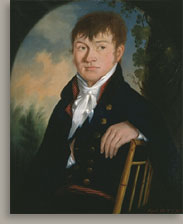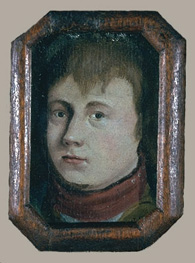 John Ritto Penniman John Ritto Penniman
Portrait of a Man, 1804
Description
Portrait of a Man is a half-length view of a man turned three-quarters left and looking forward. His brown hair is combed in wisps that fall across his forehead and the upper parts of his cheeks. The sitter’s proper right eyebrow arches higher than the left one above his pale blue eyes. His face is nearly round, though it narrows slightly at the chin. A light coming from the right side casts shadows behind and to the left of his nose and neck cloth. The man’s costume consists of a black coat worn over a red waistcoat and white shirt with a stiffly starched collar. The outfit is ornamented with a simple white stock, a white bow, and a white shirt ruffle. Penniman conveyed the texture of these textiles with long brushstrokes of white over gray paint. The portrait is painted in an oval format with black spandrel corners. The background is a loosely defined landscape with a peach and blue sky at upper left, water at lower left, and a tree behind the man’s shoulder at upper right.
Analysis
|
 |
 |
Figure 1. John Ritto Penniman, Aaron Willard, Jr., 1804, oil on canvas, 29 1/8 x 24 in. (74 x 61 cm), Willard House and Clock Museum, North Grafton, Massachusetts.
|
Portrait of a Man belongs to a small group of works that Penniman completed at about the time that he moved from the ranks of apprentice to independent painter. At least three of those paintings represent members of the Willard family who were Penniman’s neighbors in Roxbury prior to his move to Boston in 1804: Aaron Willard (1804, private collection), Aaron Willard, Jr. (fig. 1), and Nancy Willard (1804, Willard House and Clock Museum, North Grafton, Mass.). The latter two paintings are especially similar to Portrait of a Man, as they employ the same half-length format with a landscape background and spandrel corners. The frames on the portraits of Aaron, Jr. and Nancy Willard and Portrait of a Man are alike, and were probably among the frames that Penniman purchased in 1804 from fellow Roxbury craftsman John Doggett. Penniman also inscribed the likenesses of the Willard siblings in a similar manner to the painting in Worcester’s collection. At the bottom right of the portrait of Aaron, Jr., Penniman wrote in red paint, "Aged 20, Y 7 M," and on the reverse in black paint, "Painted by/ John R Penniman/ in Jany 1804." Portrait of a Man is also inscribed on the front with the age of the sitter and on the back with artist’s name and the date of the painting.
As Penniman scholar Carol Damon Andrews has observed, Worcester’s Portrait of a Man and the related Willard portraits combine decorative and academic painting techniques.1 The format, painterly brushstrokes, and generalized landscape background reflect Penniman’s absorption of contemporary fine art studio practices, whereas the high key palette, lack of modeling, and inscription suggest the hand of a decorative painter. At this early point in his career, the two styles appear to be in tension.
 |
 |
Figure 2. John Ritto Penniman, Self-Portrait in Miniature, 1796, oil on paper, 3 x 2 1/4 in. (7.6 x 5.7 cm), private collection.
|
|
While the sitter remains unidentified, there is a slight possibility that Portrait of a Man is a self-portrait. Penniman painted himself in miniature as a boy of fourteen (fig. 2), and if this is the artist’s own likeness it may have been intended to mark his reaching majority age. The head in each portrait is nearly round, though the man in the later portrait has a slightly narrower chin. The eyes in the miniature are considerably smaller in proportion to the face as compared to the eyes in the full-size portrait. Another difference is that the cheek line in the miniature has a slight swell near the eye, whereas the same line in the larger image is a continuous curve. These differences may reflect improvements in Penniman’s drawing skills or, more likely, suggest separate identities for the two sitters. A firm birth date for Penniman might also rule out the artist as the subject of Portrait of a Man. The inscription on the front of the painting implies that the man depicted was born about February 1782; Penniman was born about 1782. However, an inscription on the back of the painting, which is now only partially visible, gives the sitter’s death date as 1813. Penniman died in 1841. If the painting is not a self-portrait, the resemblance to the Willard portraits suggests that the sitter might also have been a friend or a member of Penniman’s professional circle. Further study of the telescope-like object that Penniman removed from the background of Portrait of a Man might also provide a clue as to the sitter’s identity.
Note
1. Andrews 1981, 147. |